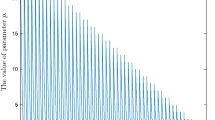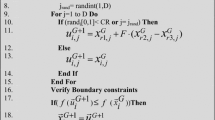Abstract
Differential evolutionary (DE) algorithm is one of the most frequently used evolutionary computation method for the solution of non-differentiable, complex and discontinuous real value numerical problems. The analytical structure of the mutation and crossover operators used by DE and the initial values of the parameters of the relevant operators affect the problem-solving ability of DE. Unfortunately, there is no analytical method for selecting and initializing the best artificial genetic operators that DE can use to solve a problem. Therefore, there is a need to develop new evolutionary search methods that are parameter-free and insensitive to the artificial genetic operators they use. In this paper, the Bernstein–Levy differential evolution (BDE) algorithm, which has a unique elitist-mutation operator and a Bernstein polynomials-based stochastic parameter-free crossover operator, is introduced. The numerical problem-solving success of BDE is statistically evaluated by using 30 benchmark problems of CEC2014 in the numerical experiments presented. BDE's success in solving the related benchmark problems is statistically compared with six state-of-the-art comparison algorithms. In this paper, three real-world optimization problems are also solved by using the proposed algorithm, BDE. According to statistics generated from the experimental results, BDE is statistically better than comparison methods in solving the related real-world problems.










Similar content being viewed by others
Explore related subjects
Discover the latest articles and news from researchers in related subjects, suggested using machine learning.Code availability
Name of the code/library: ReadMe.m; algo_bde.m; fncdata.mat; kowalik.m; rastring.m; rosenbrock.m, license.txt. Contact: ebesdok@erciyes.edu.tr, + 90-352-207 66 66 (32650). Hardware requirements: Windows 10 OS. Program language: Matlab 2022a. Software required: Matlab 2022a. Program size: ReadMe.m 1 KB; algo_bde.m 5 KB; fncdata.mat 1 KB; kowalik.m 1 KB; rastring.m 1 KB; rosenbrock.m 1 KB, license.txt 2 KB. The source codes are available for downloading at the link: Github, 2022. https://github.com/BESDOK/Bernstein-Levy-Differential-Evolution-Algorithm-BDE-.
References
Das S, Suganthan PN (2011) Differential evolution: a survey of the state-of-the-art. IEEE T Evolut Comput 15:4–31
Storn R, Price K (1997) Differential evolution - a simple and efficient heuristic for global optimization over continuous spaces. J Global Optim 11:341–359
Civicioglu P (2012) Transforming geocentric cartesian coordinates to geodetic coordinates by using differential search algorithm. Comput Geosci 46:229–247
Civicioglu P (2013) Artificial cooperative search algorithm for numerical optimization problems. Inform Sci 229:58–76
Civicioglu P (2013) Backtracking search optimization algorithm for numerical optimization problems. Appl Math Comput 219:8121–8144
Peng H, Qian JY, Kong FR, Fan DB, Shao P, Wu ZJ (2022) Enhancing firefly algorithm with sliding window for continuous optimization problems. Neural Comput Appl. https://doi.org/10.1007/s00521-022-07193-6
Civicioglu P, Besdok E (2013) A conceptual comparison of the Cuckoo-search, particle swarm optimization, differential evolution and artificial bee colony algorithms. Artif Intell Rev 39:315–346
Civicioglu P, Besdok E (2018) A plus evolutionary search algorithm and QR decomposition based rotation invariant crossover operator. Expert Syst Appl 103:49–62
Civicioglu P, Besdok E (2019) Bernstain-search differential evolution algorithm for numerical function optimization. Expert Syst Appl 138:18
Civicioglu P, Besdok E (2021) Bezier search differential evolution algorithm for numerical function optimization a comparative study with CRMLSP, MVO, WA. SHADE and LSHADE Expert Syst Appl 165:14
Civicioglu P, Besdok E, Gunen MA, Atasever UH (2020) Weighted differential evolution algorithm for numerical function optimization: a comparative study with Cuckoo search, artificial bee colony, adaptive differential evolution, and backtracking search optimization algorithms. Eural Comput Appl 32:3923–3937
Eltaeib T, Mahmood A (2018) Differential evolution: a survey and analysis. Appl Sci 8:25
Civicioglu P, Besdok E (2022) Contrast stretching based pansharpening by using weighted differential evolution algorithm. Expert Syst Appl 208:118144
Wu GH, Shen X, Li HF, Chen HK, Lin AP, Suganthan PN (2018) Ensemble of differential evolution variants. Inf Sci 423:172–186
Gunen MA (2021) Weighted differential evolution algorithm based pansharpening. Int J Remote Sens 42:8468–8491
Gunen MA, Besdok E, Civicioglu P, Atasever UH (2020) Camera calibration by using weighted differential evolution algorithm: a comparative study with ABC, PSO, COBIDE, DE, CS, GWO, TLBO, MVMO, FOA, LSHADE ZHANG and BOUGUET. Neural Comput Appl 32:17681–17701
Choi TJ, Ahn CW (2014) An adaptive cauchy differential evolution algorithm with bias strategy adaptation mechanism for global numerical optimization. J Comput 9:2139–2145
Zhan ZH, Wang ZJ, Jin H, Zhang J (2020) Adaptive distributed differential evolution. IEEE T Cybern 50:4633–4647
Zhang YX, Gou J (2019) Adaptive differential evolution algorithm based on restart mechanism and direction information. IEEE Access 7:166803–166814
Karaboga D, Akay B (2009) A comparative study of artificial bee colony algorithm. Appl Math Comput 214:108–132
Yang XS, Deb S (2014) Cuckoo search: recent advances and applications. Neural Comput Appl 24:169–174
Brown C, Jin YC, Leach M, Hodgson M (2016) JADE: adaptive differential evolution with a small population. Soft Comput 20:4111–4120
Wang Y, Li HX, Huang TW, Li L (2014) Differential evolution based on covariance matrix learning and bimodal distribution parameter setting. Appl Soft Comput 18:232–247
Awad NH, Ali MZ, Suganthan PN, Reynolds RG (2016). An ensemble sinusoidal parameter adaptation incorporated with L-SHADE for solving CEC2014 benchmark problems. In: IEEE congress on evolutionary computation CEC held as part of IEEE world congress on computational intelligence IEEE WCCI pp. 2958–2965. Vancouver, Canada, IEEE
Elsayed SM, Sarker RA, Essam DL, Hamza NM (2014) Testing united multi-operator evolutionary algorithms on the CEC2014 real-parameter numerical optimization. In: IEEE Congress on evolutionary computation CEC. pp 1650–1657. Beijing, IEEE
Liang JQB, Suganthan P (2013) Problem definitions and evaluation criteria for the CEC 2014 special session and competition on single objective real-parameter numerical optimization, technical report 201311. In: Computational intelligence laboratory, Zhengzhou University, Zhengzhou, China and technical report, Nanyang Technological University, Singapore
Besdok E (2022) https://www.mathworks.com/matlabcentral/fileexchange/115155-bernstein-levy-differential-evolution-algorithm-bde
Github (2022) https://github.com/BESDOK/Bernstein-Levy-Differential-Evolution-Algorithm-BDE-
Abdelfatah RI (2020) A color image authenticated encryption using conic curve and Mersenne twister. Multimed Tools Appl 79:24731–24756
Derrac J, Garcia S, Molina D, Herrera F (2011) A practical tutorial on the use of nonparametric statistical tests as a methodology for comparing evolutionary and swarm intelligence algorithms. Swarm Evol Comput 1:3–18
Atlasus (2022) https://3dgradgeo.com/tr/urunler/hava-ekipman-satis/atlasus-uav/
Turef (2022) https://www.tusaga-aktif.gov.tr/
Civicioglu P, Alci M (2004) Impulsive noise suppression from highly distorted images with triangular interpolants. AEU-Int J Electron C 58:311–318
Besdok E, Civicioglu P, Alci M (2004) Impulsive noise suppression from highly corrupted images by using resilient neural networks. Artif Intell Soft Comput ICAISC 2004(3070):670–675
Civicioglu P, Alci M, Besdok E (2004) Using an exact radial basis function artificial neural network for impulsive noise suppression from highly distorted image databases. Adv Inf Syst Proceed 3261:383–391
Civicioglu P, Alci M, Besdok E (2004) Impulsive noise suppression from images with the noise exclusive filter. EURASIP JASP 2004(16):2434–2440
Gunen MA, Civicioglu P, Besdok E (2016) Differential search algorithm based edge detection. XXIII ISPRS Congress Commission VII 41(B7):667–670
Chauhan D, Unnikrishnan A, Figliozzi M (2019) Maximum coverage capacitated facility location problem with range constrained drones. Transport Res C-Emer 99:1–18
Vazquez-Carmona EV, Vasquez-Gomez JI, Herrera-Lozada JC, Antonio-Cruz M, Coverage path planning for spraying drones (2022) Comput Ind Eng. 168: 108125
Zorbas D, Pugliese LDP, Razafindralambo T, Guerriero F (2016) Optimal drone placement and cost-efficient target coverage. J Netw Comput Appl 75:16–31
Zhang B, Song J, Liu Z, Yang K (2021) Genetic algorithm enabled particle swarm optimization for aerial base station deployment. In: IEEE 94th Vehicular Technology Conference. VTC2021-Fall. https://doi.org/10.1109/VTC2021-FALL52928.2021.9625338
Wang H, Li H, Zhang C, He S, Liu J (2017) A 3D coverage path planning approach for flying cameras in nature environment under photogrammetric constraints. In: Proceedings of the 36th Chinese control conference July 26–28, Dalian, China. https://doi.org/10.23919/ChiCC.2017.8028424
Huang Y, Xu J, Shi M, Liu L. (2022). Time-Efficient Coverage Path Planning for Energy-Constrained UAV. Wirel Commun Mob Com. 5905809. https://doi.org/10.1155/2022/5905809
Liu C, Zhang S, Akbar A (2019) Ground feature oriented path planning for unmanned aerial vehicle mapping. IEEE J Sel Top Appl 12(4):1175–1187
NASA (2022) https://speclib.jpl.nasa.gov/
RSLAB (2022) https://rslab.ut.ac.ir/-/remote-sensing-datasets (Urban_R162.mat)
Sun S, Rappaport TS, Thomas TA, Ghosh A, Nguyen HC, Kovacs IZ, Rodriguez I, Koymen O, Partyka A (2016) Investigation of prediction accuracy, sensitivity, and parameter stability of large-scale propagation path loss models for 5G wireless communications. IEEE T Veh Technol 65(5):2843–2860
Seybold JS (2005) Introduction to RF propagation. Wiley, Hoboken
Yun Z, Iskander MF (2015) Ray tracing for radio propagation modeling: principles and applications. IEEE Access 3:1089–1100
Schaubach KR, Davis NJ, Rappaport TS (1992) A ray tracing method for predicting path loss and delay spread in microcellular environments. In: Vehicular technology society 42nd VTS conference-frontiers of technology, 932–935. Denver, CO, USA: IEEE, 1992
Zuliang W, Mao Z, Juan W, Linhua Z (2008) Improved algorithm of atmospheric refraction error in Longley-Rice channel model. J Syst Eng Electron 19(4):683–687
Friis HT (1946) A note on a simple transmission formula. IRE Proc 34(5):254–256
Hufford G (2002) The ITS Irregular Terrain Model, version 1.2.2, itm.alg.pdf . https://www.its.bldrdoc.gov/resources/radio-propagationsoftware/itm/itm.aspx
Longley AG, Rice PL (1968) Prediction of tropospheric radio transmission loss over irregular terrain: a computer method-1968. Institute for telecommunication sciences (ITS). NTIA
Marianov V, Eiselt HA (2012) Transmitter location for maximum coverage and constructive-destructive interference management. Comput Oper Res 39:1441–1449
Cgiar (2022) https://srtm.csi.cgiar.org/download (Product: SRTM 90m DEM Version 4, Data File Name: srtm_44_05.zip)
Mathworks (2022) https://www.mathworks.com/products/antenna.html (please see the ‘coverage’ and ‘txsite’ commands of related toolbox of Matlab 2022a)
Author information
Authors and Affiliations
Corresponding author
Ethics declarations
Conflicts of interest
The authors declare that they have no conflict of interest. This manuscript does not contain any studies with human participants or animals performed by any of the authors. Authors have carefully checked the “Instructions for Authors” and certify that the manuscript complies with the ethical rules applicable for this journal.
Additional information
Publisher's Note
Springer Nature remains neutral with regard to jurisdictional claims in published maps and institutional affiliations.
Rights and permissions
Springer Nature or its licensor (e.g. a society or other partner) holds exclusive rights to this article under a publishing agreement with the author(s) or other rightsholder(s); author self-archiving of the accepted manuscript version of this article is solely governed by the terms of such publishing agreement and applicable law.
About this article
Cite this article
Civicioglu, P., Besdok, E. Bernstein-Levy differential evolution algorithm for numerical function optimization. Neural Comput & Applic 35, 6603–6621 (2023). https://doi.org/10.1007/s00521-022-08013-7
Received:
Accepted:
Published:
Issue Date:
DOI: https://doi.org/10.1007/s00521-022-08013-7




